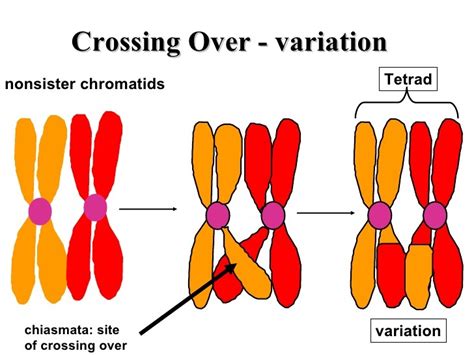Crossing over is a genetic process that occurs during meiosis in sexually reproducing organisms. It is a crucial step that results in genetic recombination, leading to genetic diversity and the inheritance of new traits.

How Does Crossing Over Occur?
During meiosis, the chromosomes in a cell are duplicated and then aligned in pairs. Each pair consists of one chromosome from each parent. The chromatids of each chromosome then exchange genetic material through a process called crossing over.
This exchange involves breaking and rejoining the ends of non-sister chromatids, resulting in the formation of recombinant chromosomes. Recombinant chromosomes contain a combination of genetic material from both parents, creating new and diverse genetic combinations.
The Results of Crossing Over
The primary result of crossing over is genetic recombination. Recombination leads to the formation of new and diverse genetic combinations that are not present in the parent cells. This diversity is essential for the following reasons:
- Increased Genetic Variation: Crossing over creates new combinations of alleles, increasing the genetic variation within a population.
- Adaptation to Changing Environments: Genetic recombination allows populations to adapt to changing environmental conditions. New combinations of alleles can produce individuals with traits that enhance survival and reproduction.
- Prevention of Inbreeding: Crossing over minimizes the effects of inbreeding by introducing genetic diversity and reducing the likelihood of inherited genetic disorders.
Applications of Crossing Over
The principles and benefits of crossing over have been widely used in various applications, including:
- Plant and Animal Breeding: Crossing over is utilized in the controlled breeding of plants and animals to create new varieties with desirable traits, such as improved crop yield or disease resistance.
- Biotechnology: Crossing over techniques have been employed in genetic engineering to create genetically modified organisms, such as the production of human insulin in bacteria.
- Disease Research: Studying crossing over can help identify genetic variations associated with diseases, leading to the development of new diagnostic and therapeutic tools.
Impact on Evolution
Crossing over is a fundamental process in evolution. It allows for the exchange of genetic material between different individuals, thereby increasing the genetic diversity within a population. This diversity provides the raw material for natural selection to act upon, driving the evolution of new species and adaptations.
Tips and Tricks
- To maximize genetic diversity through crossing over, breeders can use a wide range of genetic resources and employ techniques such as artificial insemination or embryo transfer.
- Geneticists can identify specific genetic recombination hotspots where crossing over is more likely to occur, enabling them to target particular regions of the genome for manipulation.
- Bioinformatics tools can analyze genetic data to detect patterns of crossing over and identify genetic variants associated with complex traits.
Common Mistakes to Avoid
- Ignoring the Role of Crossing Over: Underestimating the importance of crossing over can lead to a lack of genetic diversity and hinder the success of genetic improvement programs.
- Overestimating the Impact of Crossing Over: While crossing over is essential for genetic diversity, it alone cannot create new alleles or introduce completely novel traits.
- Assuming Crossing Over Occurs Randomly: Crossing over is not a completely random process and can be influenced by genetic factors and environmental cues.
FAQs
-
What percentage of the genome undergoes crossing over?
– The percentage varies among species and genomic regions, but typically ranges from 1-3%. -
Is crossing over essential for life?
– Yes, crossing over is essential for meiosis and sexual reproduction. Organisms that do not undergo crossing over have reduced genetic diversity and reproductive fitness. -
Can crossing over cause genetic disorders?
– Yes, improper or abnormal crossing over can result in chromosomal abnormalities and genetic disorders, such as trisomy and Down syndrome. -
How can I induce crossing over in research?
– Researchers can use techniques like temperature stress or chemical mutagens to increase the frequency of crossing over in experimental populations. -
Is crossing over reversible?
– No, once crossing over occurs, the genetic material is permanently exchanged, and the changes cannot be reversed through genetic recombination. -
Can polyploid plants undergo crossing over?
– Yes, but polyploidy can affect the pairing and recombination of chromosomes during meiosis, leading to complex patterns of crossing over. -
What technologies can detect crossing over?
– Technologies like genetic mapping, microarrays, and next-generation sequencing can be used to detect and analyze patterns of crossing over in genomic data. -
What are the potential risks of using crossing over in genetic engineering?
– Unintended genetic changes or the introduction of recombination breakpoints can occur, leading to unpredictable effects on gene expression or genomic stability.
